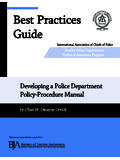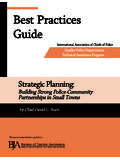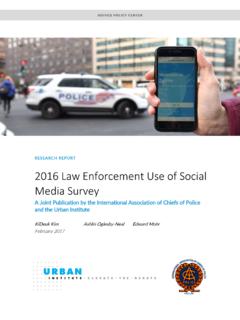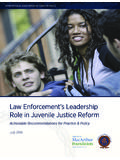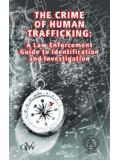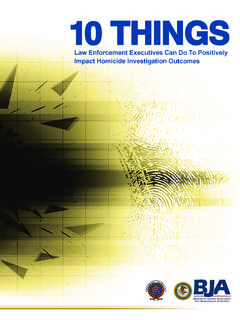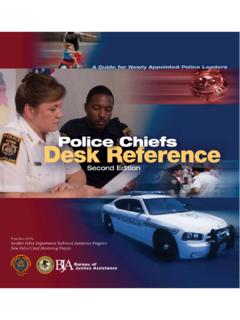Transcription of Police-Youth Engagement - International Association of ...
1 This project was supported, in whole or in part, by cooperative agreement number 2016-CRWX-K002 awarded by the Office of Community Oriented Policing Services, US Department of Justice. The opinions contained herein are those of the author(s) and do not necessarily represent the official position or policies of the US Department of Justice. References to specific agencies, companies, products, or services should not be considered an endorsement by the author(s) or the US Department of Justice. Rather, the references are illustrations to supplement discussion of the issues.
2 The internet references cited in this publication were valid as of the date of publication. Given that URLs and websites are in constant flux, the author(s) cannot vouch for their current validity. Recommended citation: International Association of Chiefs of police . 2018. Police-Youth Engagement . Practices in Modern Policing. Alexandria, VA: International Association of Chiefs of 2018 CONTENTSI ntroduction ..1 Law enforcement s influence on youth ..1 youth Engagement recommendations from the task force report.
3 3 Promising Programs for youth Engagement ..5 Arlington (Texas) police Department ..5 Camden (New Jersey) police Department ..8 Columbia (South Carolina) police Department ..9 Doral (Florida) police Department ..9 Gun Lake Tribal Public Safety Department, Michigan ..10 Indio (California) police Department ..11 Louisville (Kentucky) Metropolitan police Department ..12 Considerations for Implementing youth Engagement Strategies ..14 Conclusion ..18 Appendix A. History of the Task Force on 21st Century Policing.
4 19 Pillar 1. Building Trust and Legitimacy ..19 Pillar 2. Policy and Oversight ..19 Pillar 3. Technology and Social Media ..20 Pillar 4. Community Policing and Crime Reduction ..20 Pillar 5. Training and Education ..20 Pillar 6. Officer Wellness and Safety ..20 Appendix B. The Advancing 21st Century Policing Initiative and Its 15 Model Sites21 About the IACP ..23i vAs part of the Project Scout/Good Deed Program, a police officer in Doral, Florida, awards a child a certificate and prize to recognize good : Doral (Florida) police Department1 INTRODUCTIONThe Task Force on 21st Century Policing,1 established by US President Barack Obama in 2014, heard from practitioners, subject matter experts, and other stakeholders through numerous listening sessions and written testimonies both of which had a reccurring theme of juvenile justice.
5 Working from the foundation of the task force s final report,2 this guide demonstrates how positive police and youth Engagement can increase public safety; reduce crime, victimization, and recidivism; and foster trust between young people and law enforcement. The guide includes background material on the issues surrounding Police-Youth interactions and examples of model programs for youth Engagement . 1. The task force comprised experts in the fields of policing, criminal justice, civil rights, academia, and other arenas, who worked together to identify best practices to reduce crime and build trust between the public and law enforcement.
6 The task force s final report identified 59 recommendations and 92 action items. For details, see appendix Final Report of the President s Task Force on 21st Century Policing (Washington, DC: Office of Community Oriented Policing Services, 2015), 5, enforcement s influence on youthYouth interactions present a unique set of challenges and opportunities for law enforcement. For many youth , their first encounter with anything justice-related whether in school, their neighborhoods, or social service settings is through law enforcement.
7 The nature and circumstances of this contact can have a significant and lasting impression on a young person. Concerned adults, mentors, and role models can assist adolescents in achieving social competence and reducing problem behavior. police officers are in a strong position to take on this role of influencing youth and promoting positive and productive outcomes when they interact. A law enforcement officer who builds a good relationship with youth can be a strong, protective figure for Officers have many opportunities to engage with young people.
8 More than four million youth who are 16 and 17 years old have face-to-face interactions with law enforcement each However, while research finds that positive interactions with police are predictive of positive attitudes toward the police , negative interactions are predictive of negative While juvenile arrests for all offense types have declined 65 percent since their peak in 1996, more than three million juveniles are arrested each Of the 1,319,700 juvenile arrests in 2012 for most serious offenses, 224,200 arrests (17 percent) were 3.
9 The Effects of Adolescent Development on Policing (Washington, DC: International Association of Chiefs of police , ), 2, Matthew R. Durose et al., Contacts between police and the Public, 2005, Special Report (Washington, DC: Bureau of Justice Statistics, 2007), 2, , quoted in Lisa H. Thurau, Rethinking How We police youth : Incorporating Knowledge of Adolescence into Policing Teens, Children s Legal Rights Journal 29, no. 3 (2009): 32, 5. Elena T. Broaddus et al., Building Connections between Officers and Baltimore City youth : Key Components of a Police-Youth Teambuilding Program, Journal of Juvenile Justice 3, no.
10 1 (2013): 49, Juvenile Arrest Rates for All Crimes, 1980-2014, Statistical Briefing Book, Office of Juvenile Justice and Delinquency Prevention, December 13, 2015, larceny-theft, 140,000 (11 percent) were for drug abuse violations, and 120,100 (9 percent) were for disorderly Arresting youth for minor offenses or for the purpose of teaching them to respect authority can have harmful, long-term consequences for young people and foster broader negative community the years, a number of studies have documented the strained relationship between law enforce-ment and youth , specifically youth who are (1) from urban environments, (2) from lower socio-economic areas, (3) male, and (4) a minority.
